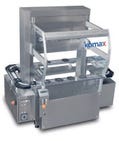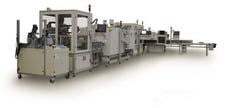June 28, 2010
 Modular Machine Performs Small-Part Assembly
Modular Machine Performs Small-Part Assembly
A standardized, modular assembly machine designed specifically for the medical device industry is suited for use in the production of test kits, syringes, needle sets, and other medical products. Capable of operating at rates up to 120 parts per minute, the QuickLink linear indexing system performs ultrasonic welding, UV bonding, and small-part assembly tasks. Among the system's features is the ability to self-diagnose problems and then decide on an optimal course of action using the company's 'smart' programming techniques. Configured with a steel welded frame and aluminum work surface, the machine is equipped with a 2- or 4-m working zone. It is available in partially or fully automated versions and can be integrated with the company's QuickPouch packaging systems.
Adaptive Manufacturing Technologies
Ronkonkoma, NY
www.amtautomation.com
 Assembly System is 25% Smaller than Similar Equipment
Assembly System is 25% Smaller than Similar Equipment
Featuring a footprint that measures approximately 6.5 by 6.5 ft, an automatic medical device assembly system is about 25% smaller than a typical pilot-scale machine, according to its manufacturer. Configurable as a semiautomatic or fully automatic system, the KS Pilot is compatible with the company's KSL and KSD platforms, which enables validated processes and stations to be transferred or duplicated on a high-speed automated assembly line. This capability, the company states, can reduce time and costs. The entire system can also be reused or retooled for new applications, when required. It can be employed as a stand-alone machine or can accommodate multiple units strung together to create a large automated assembly system. Applications include safety syringes, inhalers, and diagnostic devices.
Komax Medtech
Rockford, IL
www.komaxmedtech.com
 Hybrid Welding Machine Joins 3-D Plastic Parts
Hybrid Welding Machine Joins 3-D Plastic Parts
Joining complex 3-D parts can be accomplished by a company's robot-supported hybrid welding system. Capable of yielding welded assemblies for medical applications, the TwinWeld3D machine performs laser plastic welding operations that offer high welding-seam quality and fast processing times, according to its manufacturer. Based on dual irradiance, the welding technology combines laser light with the infrared radiation emitted by conventional halogen heating lamps. As a result, the company says that its technology can increase processing speeds and fault tolerances.
LPKF Laser & Electronics North America
Orion, MI
www.laserequipment.com
 Modular Conveyor System Is Suited for Cleanroom Use
Modular Conveyor System Is Suited for Cleanroom Use
Touted by its manufacturer as the first truly modular system to meet ISO Class 3 standards, a conveyor is optimized for cleanroom use. Many conveyors cannot meet Class 3 standards for cleanroom environments because they require particulate-emitting lubricants. The DynaCon conveyor, however, does not require lubrication and has been rated to meet the ISO standard by an independent laboratory. Lightweight and portable, the conveyor promotes lean manufacturing principles and flexibility for medical device assembly operations. It is based on a building-block concept of high-impact, interchangeable plastic modules, accessories, and components.
Dynamic Conveyor Corp.
Muskegon, MI
www.dynamicconveyor.com
 Automated Conveyor Line Performs Multiple LSR Production Steps
Automated Conveyor Line Performs Multiple LSR Production Steps
Custom-designed, fully automated conveyor systems are available to medical device OEMs for the manufacture of liquid silicone rubber (LSR)-based products. A custom, fully automated line can perform dispensing, filling, and curing processes. If desired, production-line assembly can be carried out by filling the dispensed medical-grade LSR into a complex mold and allowing it to cure inside to ultimately yield the finished product. Monitoring and control mechanisms are implemented during each step. Automation minimizes the opportunity for human error while ensuring repeatability.
Scheugenpflug Inc.
Kennesaw, GA
www.scheugenpflug-usa.com
You May Also Like


